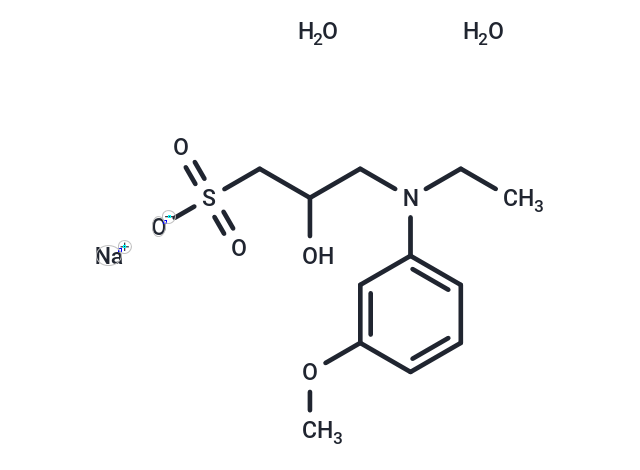Shopping Cart
Remove All Your shopping cart is currently empty
Your shopping cart is currently empty
ADOS (82692-96-4) is a biochemical and chromogenic reagent.

| Pack Size | Price | USA Warehouse | Global Warehouse | Quantity |
|---|---|---|---|---|
| 10 mg | $30 | In Stock | In Stock | |
| 25 mg | $48 | In Stock | In Stock | |
| 50 mg | $68 | In Stock | In Stock | |
| 100 mg | $103 | In Stock | In Stock | |
| 200 mg | $139 | In Stock | In Stock | |
| 1 mL x 10 mM (in DMSO) | $29 | In Stock | In Stock |
| Description | ADOS (82692-96-4) is a biochemical and chromogenic reagent. |
| Cell Research | I. Detection of nitroaromatics and aldehydes 1. Solution preparation: Dissolve ADOS in an appropriate solvent (usually ethanol or water) to prepare a 0.1%-1% solution. 2. Sample treatment: Add ADOS solution to a sample containing the target analyte (such as nitroaromatic compounds or aldehydes). 3. Incubation: The reaction is carried out at room temperature or slightly higher temperature (depending on the requirements of the analyte). 4. Observation of color change: The color change indicates the presence of the target analyte, and the reaction is due to the formation of a complex between ADOS and the analyte. The color change can be monitored by the naked eye. 5. Quantification: For quantitative analysis, a spectrophotometer can be used to measure the absorbance at the corresponding wavelength to correlate the intensity of the color change with the concentration of the analyte. II. Detection of free amines 1. Sample preparation: Dissolve the sample containing free amines in an aqueous solution. 2. Reaction with ADOS: Add ADOS reagent to the sample and incubate. The presence of free amines will cause a color change and form a chromogenic complex. 3. Color development: The intensity of the color change can be used to determine the concentration of free amines. 4. Quantitative analysis: A spectrophotometer is used to measure the absorbance of the chromogenic complex to quantify amines. III. Detection of reducing sugars 1. Sample preparation: Dissolve the sample containing reducing sugars in water or buffer. 2. Reaction with ADOS: Add ADOS solution to the sample and incubate to form a chromogenic complex. 3. Color observation: The color change indicates the presence of reducing sugars in the sample. 4. Spectrophotometric quantification: The concentration of reducing sugars is quantified by measuring the absorbance of the chromogenic complex formed. |
| Molecular Weight | 311.33 |
| Formula | C12H18NNaO5S |
| Cas No. | 82692-96-4 |
| Smiles | O.O.[Na+].CCN(CC(O)CS([O-])(=O)=O)c1cccc(OC)c1 |
| Relative Density. | no data available |
| Storage | keep away from direct sunlight | Powder: -20°C for 3 years | In solvent: -80°C for 1 year | Shipping with blue ice/Shipping at ambient temperature. | |||||||||||||||||||||||||||||||||||
| Solubility Information | DMSO: 55 mg/mL (176.66 mM), Sonication is recommended. | |||||||||||||||||||||||||||||||||||
Solution Preparation Table | ||||||||||||||||||||||||||||||||||||
DMSO
| ||||||||||||||||||||||||||||||||||||
| Size | Quantity | Unit Price | Amount | Operation |
|---|

Copyright © 2015-2025 TargetMol Chemicals Inc. All Rights Reserved.